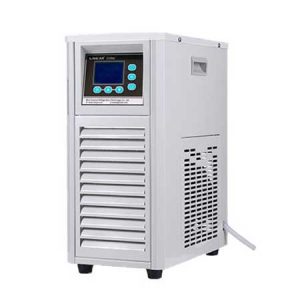liquid bath
What is a Liquid Bath?
A liquid bath is a temperature control device that uses a liquid medium, typically water or oil, to maintain precise and stable temperatures for laboratory and industrial applications. The liquid bath consists of a reservoir filled with the liquid, a heating or cooling element, and a temperature control system. Liquid baths are essential for experiments and processes that require accurate temperature regulation, such as chemical reactions, sample testing, and equipment calibration.

How Does a Liquid Bath Work?
Liquid baths operate by heating or cooling the liquid medium to the desired temperature and maintaining it within a narrow range. The basic working process involves:
Temperature Control: The liquid bath heats or cools the liquid medium using a heating element or a cooling system, such as a refrigeration unit.
Temperature Regulation: A temperature sensor monitors the liquid temperature and adjusts the heating or cooling output to maintain the setpoint.
Heat Transfer: The temperature-controlled liquid transfers heat to or from the samples or equipment placed in the bath, ensuring consistent and stable conditions.
This process allows liquid baths to provide precise temperature control, even under varying thermal loads.
Types of Liquid Baths
Liquid baths can be categorized based on their functionality and design:
Water Baths: These baths use water as the liquid medium and are suitable for applications requiring temperatures up to 100°C (212°F).
Oil Baths: These baths use oil as the liquid medium and can achieve higher temperatures, often up to 300°C (572°F) or more.

Heating Baths: These baths provide precise heating for applications such as sample incubation and chemical reactions.
Cooling Baths: These baths offer cooling capabilities for processes that require sub-ambient temperatures.
Circulating Baths: These baths circulate the liquid through an external system, providing temperature control for larger setups.
Applications of Liquid Baths
Liquid baths are used in a wide range of laboratory and industrial applications, including:
Chemistry: Maintaining precise temperatures for chemical reactions, distillations, and sample analysis.
Biology: Regulating temperatures for cell culture, enzyme reactions, and microbiological studies.
Pharmaceuticals: Ensuring the stability of temperature-sensitive drugs and vaccines during production and testing.
Materials Science: Controlling temperatures for material testing and processing.
Calibration: Providing stable temperatures for calibrating laboratory equipment and sensors.
Key Features to Consider When Selecting a Liquid Bath
Temperature Range: Ensure the liquid bath can achieve the required temperature range for your application.
Stability and Accuracy: Look for liquid baths with high temperature stability and accuracy, often within ±0.1°C.
Liquid Medium: Choose the appropriate liquid medium (water or oil) based on the temperature requirements and compatibility with your samples.
Size and Capacity: Consider the size and capacity of the bath to accommodate your samples and equipment.
User Interface: Choose liquid baths with intuitive controls and programmable features for ease of use.
Safety Features: Look for liquid baths with built-in safety features, such as over-temperature protection and alarms.
Advantages of Liquid Baths

Precision: Liquid baths provide highly accurate and stable temperature control, ensuring reliable and reproducible results.
Versatility: They can be used for a wide range of applications, from heating and cooling to calibration.
Efficiency: The direct heat transfer between the liquid medium and the samples ensures efficient temperature control.
Compact Design: Many liquid baths are designed to fit in small spaces, making them ideal for crowded laboratories.
Durability: Built with high-quality materials, these baths are designed to withstand demanding laboratory environments.
Liquid Baths vs. Traditional Temperature Control Methods
Compared to traditional temperature control methods, such as air baths or sand baths, liquid baths offer several advantages:
Consistency: Liquid baths maintain a stable temperature throughout the process, reducing temperature fluctuations.
Efficiency: The direct heat transfer between the liquid medium and the samples ensures efficient temperature control.
Versatility: Liquid baths can be used for a wide range of applications and temperature ranges.
Safety: Built-in safety features help prevent accidents and equipment damage caused by overheating.
Maintenance of Liquid Baths
Regular maintenance is essential to ensure the optimal performance and longevity of liquid baths. Key maintenance tasks include:
Inspecting and cleaning the reservoir and liquid medium to prevent contamination.
Checking and replenishing the liquid to ensure proper heat transfer.
Calibrating the temperature sensor to maintain accuracy.
Inspecting the heating or cooling element for signs of wear or damage.
Monitoring system performance and addressing any issues promptly.
Proper maintenance not only extends the lifespan of the liquid bath but also improves its efficiency and reliability.
Conclusion
Liquid baths are indispensable tools in scientific research and industrial processes, providing precise and reliable temperature control for a wide range of applications. Their ability to maintain stable temperatures, even under demanding conditions, makes them a valuable asset in fields such as chemistry, biology, and pharmaceuticals. By understanding the working principles, types, and benefits of liquid baths, users can make informed decisions when selecting and maintaining these devices. As technology continues to advance, liquid baths will remain a critical component in supporting innovation and efficiency in laboratory and industrial settings.
Related recommendations
water cooled chiller system
433Water Cooled Chiller System: A Comprehensive ExplorationWater cooled chiller systems are integral to many industrial and commercial settings, playing a vital role in maintaining optimal temperatu...
View detailschiller equipment
404Chiller equipment serves as the backbone of modern cooling systems, playing a pivotal role in maintaining optimal temperatures across a wide range of environments. Whether it's ensuring comfort in...
View detailsHow to prevent moisture in the process chillers?
1210How to prevent moisture in the process chillers? 1. Equipment installation location selection When selecting the location for installing process coolers, it is important to avoid...
View detailsoil & gas process chiller
310IntroductionIn the complex and energy - intensive oil and gas industry, maintaining precise temperature control is crucial for efficient and safe operations. Oil & gas process chillers play a ...
View details
 LNEYA Chiller
LNEYA Chiller






HelloPlease log in